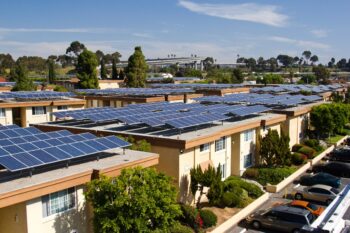SEIA Files Petition on Federal Energy Regulatory Commission Interconnection Standards
Filing seeks to update the Commission's "15 percent rule" to current industry realities
WASHINGTON – The Solar Energy Industries Association (SEIA) submitted a petition today requesting a rulemaking to update Federal Energy Regulatory Commission (FERC) interconnection standards for small photovoltaic generation. The filing targets certain provisions of the “Standardization of Small Generator Interconnection Agreements and Procedures” or “Order No. 2006,” which was established in 2005.
SEIA requests that the Commission adopt a photovoltaic-specific alternative to the “15 percent rule or screen” that applies to the “fast track” interconnection of small generation. The current law stipulates that a project can be approved for fast track interconnection only if it is less than 2 megawatts (MW) and the total distributed generation (DG) is less than 15 percent of the annual peak load. Solar projects that are ineligible for fast track must use the standard interconnection study and upgrade processes that often jeopardize project viability through higher costs and an extended timescale. SEIA’s goal is to reduce these market barriers by better aligning fast track processing screens with actual reliability and safety concerns.
“The U.S. solar industry continues to expand and create new economic opportunities across the country,” said Rhone Resch, president and CEO of SEIA. “It is essential that regulatory barriers that limit development be removed to allow companies that are developing solar projects to have access to electricity markets. SEIA is proactively engaging FERC to find a regulatory balance that maintains grid safety and reliability and facilitates fast track interconnection of wholesale distributed generation.”
The primary purpose of the 15 percent rule is to assure that DG does not produce power in excess of minimum load on a circuit and cause reverse power flows to a substation. The 15 percent of peak load standard is designed to be a very conservative proxy estimate for minimum load, which usually occurs at night. SEIA suggests a solar-only alternative to the 15 percent screen: 100 percent of minimum daytime load for the period between 10 a.m. and 2 p.m. Due to the unique timing of solar generation and minimum load, this screen is sufficiently conservative to assure with high confidence that the generation in excess of minimum load will not occur.
The 15 percent screen and 2-MW cap were not a significant barrier to solar generation deployment when the rules were adopted because of the modest amount of solar being interconnected at that time. The new petition addresses the 1000 percent growth in annual grid-connected solar energy since 2005. If adopted by FERC, SEIA’s rulemaking petition would roughly double the amount of wholesale solar DG that could be interconnected to the grid on a fast track basis.
SEIA’s request only concerns Order No. 2006 as applicable to solar due to its unique characteristics as a power resource. Solar produces no power at night, when minimum loads typically occur. Moreover, it most efficiently generates power during daylight hours when peak load levels typically occur. Both of these characteristics dramatically reduce the likelihood that solar generation will cause exceedances of minimum load. SEIA’s proposal is also carefully crafted so as to not diminish state authority to regulate the interconnection of retail distributed generation.
                                                                                                                                                ###
About SEIA:
Established in 1974, the Solar Energy Industries Association is the national trade association of the U.S. solar energy industry. Through advocacy and education, SEIA is working to build a strong solar industry to power America. As the voice of the industry, SEIA works with its member companies to make solar a mainstream and significant energy source by expanding markets, removing market barriers, strengthening the industry and educating the public on the benefits of solar energy.  www.seia.org.
Â


